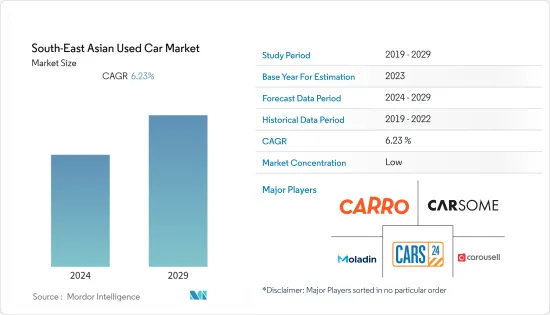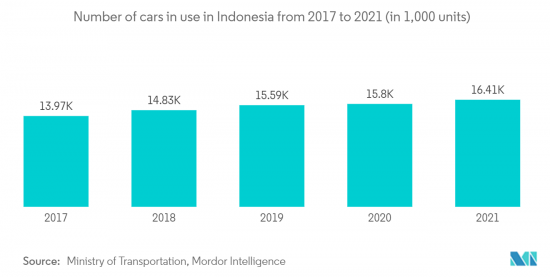PUBLISHER: Mordor Intelligence | PRODUCT CODE: 1406239

PUBLISHER: Mordor Intelligence | PRODUCT CODE: 1406239
South-East Asian Used Car - Market Share Analysis, Industry Trends & Statistics, Growth Forecasts 2024 - 2029

In the current year, Southeast Asia Used Car Market was valued at USD 62.31 billion, and it is expected to reach USD 84.30 billion by registering a CAGR of 6.23% during the forecast period.
Key Highlights
- The pandemic and the subsequent restriction, the manufacturing and demand for new cars have been hampered in the past two years. Now, as the market is still recovering, there is an increased demand for used cars, as they are relatively affordable, and cars from the last five years offer almost all the modern and necessary features.
- Consumers are refraining from investing hugely in newer vehicles and are opting to purchase used cars. As a result, the used car industry is witnessing considerable growth. Used car platforms are widely safe, accessible, and available at reasonable prices.
- Due to this, the sales of used cars are 1.3 times that of new vehicles. Also, this ratio is expected to double in the coming decade. Various factors, including population rise and economic growth, are making Southeast Asia counties the fastest and most attractive economic market to investors. Additionally, in Thailand, In 2022, the total sales volume of automobiles in Thailand amounted to around 848 thousand units.
- Automotive e-commerce has grown at a staggering rate in Thailand and Indonesian markets, with almost 100% of used car customers beginning their car shopping experience online. This allows car dealers to provide faster digital service and more accessible options to advertise their listings. Today, over 70% of used car dealers in the South East Asian market use the internet.
- Additionally, to capture the market share, many companies from other countries are also investing and starting their operations in the Southeast Asia region.
Southeast Asia Used Car Market Trends
Strengthening of Online Platforms is Driving the Market
- Based on the number of units sold and relative penetration of the used car segment, Indonesia, Thailand, and Malaysia are major markets. Around 3.5 used cars were sold for every new car in Indonesia. The number is slightly lower for Thailand, which has about two used cars for every new car.
- Because the penetration of smartphones and the internet in emerging economies, especially in Southeast Asia, is increasing, the used car market is getting more organized. Used car retailers are using digitalization to make market offerings attractive. Also, facilities like an enormous number of photos and videos on the online platform and secure online instant finance services attract customers to buy used cars.
- For instance, in June 2023, Moladin, an Indonesian used car marketplace, acquired PT Pro Car International Finance, a licensed multi-finance company. The company has rebranded PT Pro Car International Finance as PT Moladin Finance Indonesia, which will now function as Moladin's multi-finance arm.
- In May 2022, Moladin, an Indonesian used-car platform, raised USD 95 million in Series B funding led by DST Global. Other investors include East Ventures, Northstar Group, and Sequoia Capital India. This comes just four months after the company raised USD 42 million in Series A funding.
- The primary reason behind this is that consumers prefer safety, transparency, convenience, and negligible risk while purchasing used cars, which, in turn, gives the organized sector an upper edge compared to the unorganized sector.
- Hence, many new players have entered the used carmaker in many regional countries. For instance, in the last year, in Thailand, India's Cars24 and Malaysia's Carsome have entered the market to bridge the gap between the demand for new automobiles and the supply of used cars.
- Additionally, in March 2022, Cars 24 launched its application in Thailand to redefine the used car buying experience by delivering fast, convenient, and consumer-friendly services with one app.
- Also, millennials today are considering the purchase of used cars over newer ones, with a higher focus on the cost than the brand names. They are much more tech-savvy, resulting in used-car sellers focusing on strengthening their online infrastructure. As a result, we see the online marketplace adapting to proprietary pricing algorithms to inspect and evaluate vehicles. This has also helped companies improve their used-car trade and transactional framework.
- However, with the increasing number of vehicles and cities having jam-packed roads, the existing infrastructure cannot sustain increased demand. Hence, the government is pushing toward public transport, which will hinder market growth in the upcoming years. Additionally, the automobile production growth rate has remained stagnant over the last few years in South Asian nations.
- These factors will hinder the purchase of used cars. Nevertheless, the used car market remains successful compared to the newer cars, especially for those who opt for compact and budget-friendly options.

Indonesia is Expected To Witness Significant Growth
- Although Thailand is leading in the number of vehicles produced, with about 1.6 million vehicles in 2021, Indonesia takes the second spot with about 1.1 million vehicles produced. But irrespective of the car produced, the number of new passenger cars sold in the country has steadily decreased. For instance, in 2021, around 660 thousand passenger cars were sold, even though this value indicated a significant decrease compared to the previous years.
- Additionally, because of the global pandemic, most privately owned cars stood still during the time. Hence, on average, the kilometer reading on the odometer was less than the vehicle's age, which is expected to aid the studied market. Also, due to the slight dip in the GDP, people prefer used cars over new cars as they are about 40% cheaper than the new model. For instance, in May 2022, Carsome, Southeast Asia's largest integrated car e-commerce platform, acquired the digital automotive content businesses of WapCar and AutoFun from Tang Internet Limited and its subsidiaries. Following the acquisition, Carsome has set up WapCar AutoFun Sdn Bhd (WapCar) as a fully-owned subsidiary in Malaysia.
- In Indonesia, Jakarta has the most used cars sold due to its high urban population. In addition, Jakarta has the country's highest passenger car ownership rate, with about 40 cars per 100 people. This is even higher when compared to the national average, which is seven cars per 100 individuals.
- Hence, due to the declining sales even before the pandemic, the market for new cars is expected to witness hindrances, aiding the used car market in Indonesia.
Southeast Asia Used Car Industry Overview
The South-East Asian Used Car Market is hugely fragmented, with various startups and regional players such as PT. Moladin Digital, Carousell, Carro, Carsome, and Cars24 Services Private Limited. Although to have the edge over their competitors, the major rental companies are making joint ventures and partnerships to launch newer products. For instance,
In February 2022, Carsome Group, a Malaysia-headquartered used car e-commerce platform, plans to build more used car refurbishment centers in Malaysia, Indonesia, and Thailand. The company expects the demand for pre-owned cars to continue growing in the next few years.
Additional Benefits:
- The market estimate (ME) sheet in Excel format
- 3 months of analyst support
TABLE OF CONTENTS
1 INTRODUCTION
- 1.1 Study Assumptions
- 1.2 Scope of the Study
2 RESEARCH METHODOLOGY
3 EXECUTIVE SUMMARY
4 MARKET DYNAMICS
- 4.1 Market Drivers
- 4.1.1 Expanding Distribution Channels
- 4.1.2 Others
- 4.2 Market Restraints
- 4.2.1 Lack Of Trust And Transparency
- 4.2.2 Others
- 4.3 Porter's Five Forces Analysis
- 4.3.1 Threat of New Entrants
- 4.3.2 Bargaining Power of Buyers/Consumers
- 4.3.3 Bargaining Power of Suppliers
- 4.3.4 Threat of Substitute Products
- 4.3.5 Intensity of Competitive Rivalry
5 MARKET SEGMENTATION
- 5.1 By Vehicle Type
- 5.1.1 Hatchback
- 5.1.2 Sedan
- 5.1.3 Sports Utility Vehicle (SUV)
- 5.2 Fuel Type
- 5.2.1 Diesel
- 5.2.2 Gasoline/Petrol
- 5.2.3 Other Fuel Types
- 5.3 Booking Type
- 5.3.1 Offline
- 5.3.2 Online
- 5.4 By Vendor Type
- 5.4.1 Organized
- 5.4.2 Unorganized
- 5.5 By Country
- 5.5.1 Vietnam
- 5.5.2 Indonesia
- 5.5.3 Malaysia
- 5.5.4 Thailand
- 5.5.5 Singapore
- 5.5.6 Rest of South-East Asia
6 COMPETITIVE LANDSCAPE
- 6.1 Vendor Market Share**
- 6.2 Company Profiles*
- 6.2.1 Carro (Trusty Cars Pte Ltd)
- 6.2.2 Carsome Sdn Bhd
- 6.2.3 Cars24 Services Private Limited
- 6.2.4 Carousell
- 6.2.5 PT. Moladin Digita
- 6.2.6 ICar Asia Limited
- 6.2.7 OLX Indonesia
- 6.2.8 Toyota Trust (Toyota Motor Corporation)
- 6.2.9 Honda Certified (Honda Motor Corporation)
- 6.2.10 Nissan Intelligent Mobility (Nissan Motor Corporation)
7 MARKET OPPORTUNITIES AND FUTURE TRENDS
- 7.1 Online Platforms And Marketplaces




